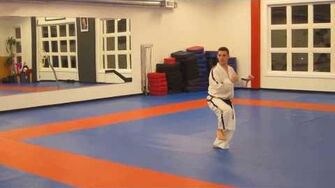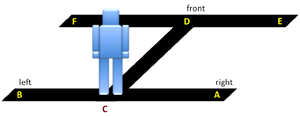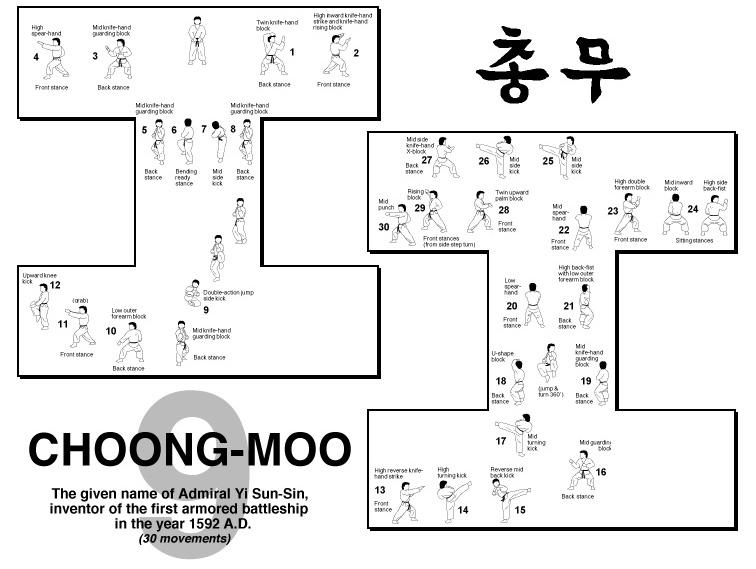
Statue of Admiral Yi

A Turtle Ship replica at the War Memorial in Seoul, South Korea
Choong-Moo is an ITF-style teul (form) named after the great Admiral Yi Soon-Sin of Korea's Yi Dynasty. Yi is credited for saving Choson Korea from the brink of collapse during the Japanese invasion of 1592. Yi is also reputed to have invented the first armored battleship (Kobukson, nicknamed the "Turtle Ship") in the year 1592. In all of his 23 major naval battles, Yi was never defeated.
In his book, The Influence of Sea on the Political History of Japan, George Alexander Ballard, a vice-admiral of the British Royal Navy, summarized Yi’s life and victories as follows:
- It is always difficult for Englishmen to admit that Nelson ever had an equal in his profession, but if any man is entitled to be so regarded, it should be this great naval commander of Asiatic race who never knew defeat and died in the presence of the enemy; of whose movements a track-chart might be compiled from the wrecks of hundreds of Japanese ships lying with their valiant crews at the bottom of the sea, off the coasts of the Korean peninsula...and it seems, in truth, no exaggeration to assert that from first to last he never made a mistake, for his work was so complete under each variety of circumstances as to defy criticism... His whole career might be summarized by saying that, although he had no lessons from past history to serve as a guide, he waged war on the sea as it should be waged if it is to produce definite results, and ended by making the supreme sacrifice of a defender of his country.
Yi is still dearly cherished in the hearts of Koreans today. In a nationwide survey conducted by Soonchunhyang University in April 2005, Yi Sun-sin was chosen as the greatest figure in Korean history by 43.8% of the vote (source: The Chosun Daily, April 15, 2005).
Videos[]
ITF Taekwon-do forms often come in two styles: Sine Wave and non-Sine Wave. In either case, the basic movements are the same. The difference is in the "up and down" motion that's used (or not), the rhythm of the movements, and the breathing. See main article Sine Wave for additional details.
Why was this video chosen for use on this wiki? Do you have a better video? Please see Video Guidelines before replacing this video with a better one.
| Sine Wave | Non-Sine Wave |
|---|---|

|

|
Diagram[]
Written Instructions[]

The lines of Choong-Moo (student view)

Tae Kwon-Do Flying Side Kick from Choong Moo & How to do it
Here on this wiki, the wording used to describe this form deviates from the conventional wording historically used to describe the form. This was done to facilitate wiki-style links to the names of associated techniques. To view the conventional wording, see ITF Forms Summary Description.
- Ready Posture: Parallel Ready Stance
- 1. Step the left foot toward B into a Right L-Stance (i.e., left foot forward) facing B. Twin Knifehand Block.
- 2. Step the right foot toward B into a Right Walking Stance facing B. Right High Knifehand Front Strike to B and bring the left backhand in front of the forehead.
- 3. Step the right foot toward A turning clockwise to form a Left L-Stance (i.e., right foot forward) facing A. Middle Knifehand Guarding Block to A.
- 4. Step the left foot toward A into a Left Walking Stance facing A. Left High Horizontal Fingertip Thrust (spearhand) to A.
- 5. Step the left foot toward D into a Right L-Stance (i.e., left foot forward) facing D. Middle Knifehand Guarding Block to D.
- 6. Turn the face to C into a left Bending Ready Stance Type A toward C.
- 7. Execute a Right Middle Side Piercing Kick to C.
- 8. Lower the right foot to C into a Right L-Stance (i.e., left foot forward) facing D. Middle Knifehand Guarding Block to D.
- 9. Execute a Right Flying Side Kick toward D then land to D into a Left L-Stance (i.e., right foot forward) facing D. Middle Knifehand Guarding Block to D.
- 10. Step the left foot toward E turning counterclockwise to form a Right L-Stance (i.e., left foot forward) facing. Left Low Block to E.
- 11. Extend both hands upward as if to grab the opponent's head, sliding the left foot into a Left Walking Stance facing E.
- 12. Execute a Right Knee Strike to E, pulling both hands downward.
- 13. Lower the right foot to the left foot, and then step the left foot toward F into a Left Walking Stance facing F. Right High Ridgehand Front Strike to F, bringing the left back hand under the right elbow joint.
- Perform 14 and 15 in a fast motion:
- 14. Execute a Right High Turning Kick to DF and then lower it to the left foot.
- 15. Execute a Middle Back Kick to F.
- 16. Lower the left foot to F into a Left L-Stance (i.e., right foot forward) facing E. Middle Guarding Block to E.
- 17. Execute a Middle Turning Kick to DE.
- 18. Lower the left foot to the right foot, then step the right foot toward C into a Right Fixed Stance facing C. U-Shaped Block toward C.
- 19. Jump and spin around counterclockwise, landing on the same spot to form a Left L-Stance (i.e., right foot forward) facing C. Middle Knifehand Guarding Block to C.
- 20. Step the left foot toward C into a Left Walking Stance facing C. Low Fingertip Thrust (upturned) to C.
- 21. Execute a Right Backfist Side Strike to D and a Left Low Block to C, sliding the left foot into a Right L-Stance (i.e., left foot forward) facing C.
- 22. Step the right foot toward C into a Right Walking Stance facing C. Right Middle Straight Fingertip Thrust to C.
- 23. Step the left foot toward B turning counterclockwise to form a Left Walking Stance facing B. Left Double Forearm High Block to B.
- 24. Step the right foot toward B into a Sitting Stance facing C. Right Middle Front Block to C and then a Right High Backfist Side Strike to B.
- 25. Execute a Right Middle Side Piercing Kick to A turning counterclockwise and then lower the foot to A.
- 26. Execute a Left Middle Side Piercing Kick to A turning clockwise.
- 27. Lower the left foot to A and then execute a X-Knifehand Checking Block to B, while pivoting with the left foot into a Left L-Stance (i.e., right foot forward) facing B.
- 28. Step the left foot toward B into a Left Walking Stance facing B, while executing a Twin Palm Upward Block to B.
- 29. Move the left foot on line AB and then execute a Right Rising Block, pulling the left foot into a Right Walking Stance facing A.
- 30. Execute a Left Middle Punch to A, while maintaining a Right Walking Stance facing A.
- End: Bring the foot back to the ready position.
ITF Color-Belt Forms[]
The other forms in the ITF-series of Color Belt forms are:
- 10th gup - no form, just basic exercises: Four Direction Punch and Block
- 9th gup - Chon-Ji (19 movements)
- 8th gup - Dan-Gun (21 movements)
- 7th gup - Do-San (24 movements)
- 6th gup - Won-Hyo (28 movements)
- 5th gup - Yul-Gok (38 movements)
- 4th gup - Joong-Gun (32 movements)
- 3rd gup - Toi-Gye (37 movements)
- 2nd gup - Hwa-Rang (29 movements)
- Basic exercise at 2nd gup: Four Direction Thrust
- 1st gup - Choong-Moo (30 movements)
References[]
The primary reference is:
The following websites are also particularly good online references for ITF-style taekwondo:
